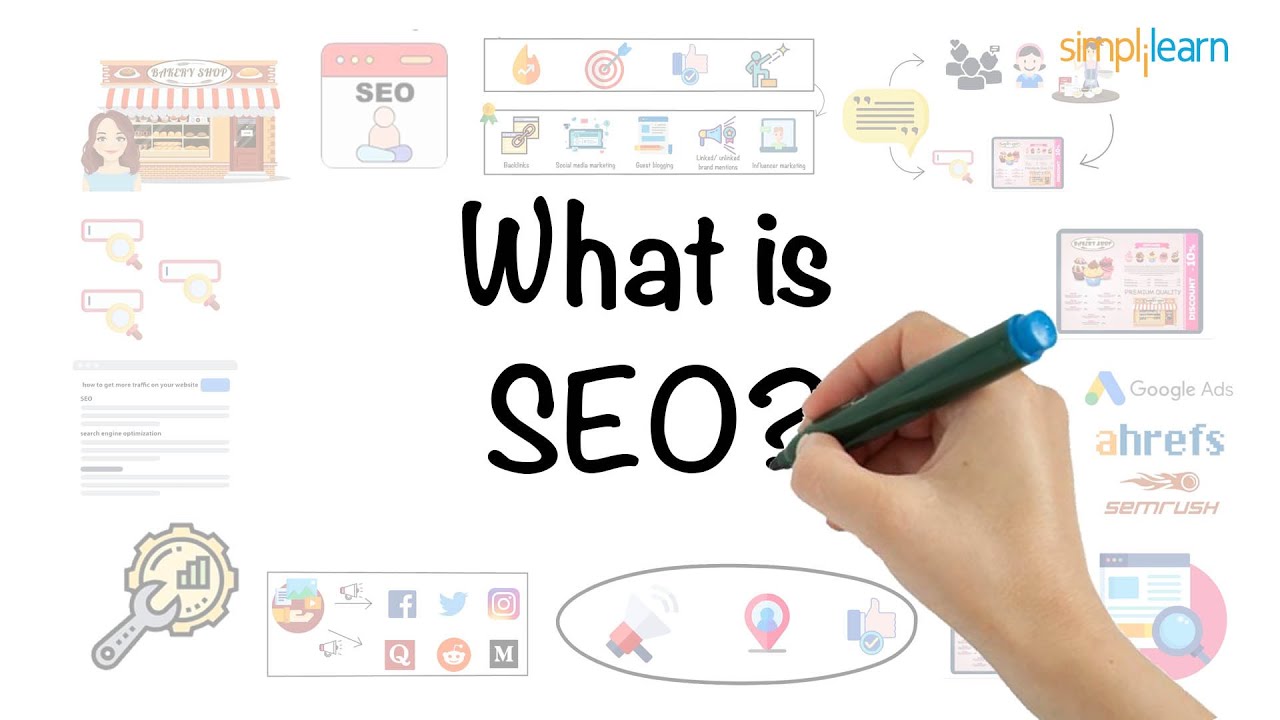In today's highly competitive digital landscape, search engine optimization(SEO) plays a pivotal role in the success of any digital marketing strategy. SEOhelps businesses improve their online visibility, attract organic traffic, and ultimately increase conversions. To help digital marketers navigate this complex field, we have compiled a list of valuable SEO tips for digital marketers.
Keeping up with the ever-evolving SEOlandscape can be challenging. From keyword research and on-page optimization to content creationand link building, these tips are designed to empower digital marketers with the knowledge and strategies needed to stay ahead in the SEO game.
Do Digital Marketers Do SEO?

SEO In 5 Minutes | What Is SEO And How Does It Work | SEO Explained | SEO Tutorial | Simplilearn
Digital marketers often play a significant role in implementing and managing SEO strategies. SEO (Search EngineOptimization) is an essential component of digital marketing as it focuses on improving a website's visibility and organic rankings in search engine results pages (SERPs). Digital marketers utilize various SEO techniques and tactics to optimize websites, generate organic traffic, and enhance online presence.
Digital marketers typically perform tasks such as conducting keyword research to identify relevant search terms, optimizing on-page elements like title tagsand meta descriptions, creating high-quality contentthat aligns with SEO best practices, building authoritative backlinks, monitoring website performance and analytics, and staying up-to-date with the latest SEO trends and algorithm changes.
By incorporating SEO into their overall digital marketing strategies, digital marketers can effectively drive targeted traffic to websites, improve user experience, and achieve higher conversions. SEO knowledge and skills are valuable assets for digital marketers in today's highly competitive online landscape.
SEO Tips For Digital Marketers

Digital Marketing for Beginners: 7 Strategies That Work
Perform Keyword Research
Performing keyword research is a fundamental step in developing a successful SEO strategyfor digital marketers. Keyword research helps identify the specific words and phrases that users enter into search engines when looking for information, products, or services. By understanding these keywords, digital marketers can optimize their website content to align with user intentand improve their organic rankings. Here are some SEO tips for performing keyword research:
- Use Keyword Research Tools -Utilize keyword research tools like Google Keyword Planner, SEMrush, Ahrefs, or Moz Keyword Explorer to discover relevant keywords. These tools provide valuable insights into search volume, competition, and related keywords.
- Consider User Intent -Understand the intent behind the keywords. Are users looking for information, making a purchase, or seeking specific services? Align your content with user intent to attract the right audience.
- Long-Tail Keywords -Target long-tail keywords that are more specific and have lower competition. Long-tail keywords often indicate high user intent and can result in better conversion rates.
- Analyze Competitor Keywords -Study the keywords your competitors are targeting. Tools like SEMrush and Ahrefs can help identify the keywords they rank for. This analysis can provide ideas for new keyword opportunities.
- Focus on Relevant and High-Volume Keywords -Prioritize keywords that are highly relevant to your businessand have a significant search volume. Targeting these keywords increases the chances of attracting more organic traffic.
- Consider Local Keywords -If your businessoperates in specific locations, include location-based keywords to target local audiences. This is particularly important for brick-and-mortar businesses or those with a specific geographical focus.
- Use a Mix of Head and Long-Tail Keywords -Strike a balance between targeting popular head keywords and specific long-tail keywords. Head keywords generate higher search volume but are more competitive, while long-tail keywords are more specific and have a higher chance of a conversion.
- Regularly Review and Update Keywords -Keep up with changing search trends and user behavior. Regularly review and update your keyword list to stay relevant and maintain a competitive edge.
Optimize On-Page Elements
Optimizing on-page elements is a crucial aspect of SEO for digital marketers. On-page optimization involves optimizing various elements on your website to make it more search engine-friendly and improve its visibility in search results. Here are some SEO tips for optimizing on-page elements:
- Title Tags -Craft unique and descriptive title tags for each webpage. Include relevant keywords at the beginning of the title to signal the page's content to search engines and users. Keep the title tag within the recommended character limit (around 50-60 characters) to ensure it displays properly in search results.
- Meta Descriptions: Write compelling meta descriptions that accurately summarize the content of each webpage. Although meta descriptions don't directly affect rankings, they can influence click-through rates. Include relevant keywords naturally while providing a concise and enticing description to encourage users to click on your link.
- Heading Tags -Use heading tags (H1, H2, H3, etc.) to structure your content and make it more readable for both users and search engines. The H1 tag should contain the main heading or title of the page and include relevant keywords. Use H2 and subsequent heading tags to divide your content into sections, providing a logical structure.
- URL Structure -Optimize your URLs by making them descriptive and keyword-rich. Use hyphens to separate words in the URL instead of underscores. Short and readable URLs are preferred by both search engines and users.
- Keyword Placement -Incorporate relevant keywords naturally throughout your webpage's content. Include them in the first paragraph, headings, subheadings, and body text, but avoid keyword stuffing, which can harm your rankings. Write for your audience first and optimize for keywords second.
- Image Optimization -Optimize images by using descriptive file names and adding alt tags that include relevant keywords. Compress images to reduce file size without compromising quality, as page load speed is a ranking factor.
- Internal Linking -Create a logical internal linking structure within your website to help search engines discover and index your content. Link relevant pages together using keyword-rich anchor text, but avoid excessive linking or over-optimization.
- Schema Markup-Implement schema markup, such as structured data, to provide additional context to search engines about your content. Schema markup can enhance search results with rich snippets, improving visibility and attracting more clicks.
- Mobile Optimization -Ensure your website is mobile-friendly and responsive. Optimize your website design and layout to provide a seamless user experience across different devices. Mobile optimization is vital for SEO since search engines prioritize mobile-friendly websites in their rankings.
- Page Speed Optimization -Improve your website's loading speed by optimizing images, minifying CSS and JavaScript files, leveraging browser caching, and utilizing content delivery networks (CDNs). Fast-loading pages enhance user experience and can positively impact search rankings.
Create Quality Content
Creating quality content is a cornerstone of successful SEO strategies for digital marketers. High-quality content not only helps you rank higher in search engine results but also engages your audience, builds trust, and encourages sharing and backlinking. Here are some SEO tips for creating quality content:
- Understand Your Target Audience -Research and understand your target audience's needs, preferences, and pain points. Tailor your content to provide relevant and valuable information that addresses their specific interests and challenges.
- Keyword Research -Conduct thorough keyword research to identify relevant keywords and topics. Use keyword research tools to find high-volume and low-competition keywords that align with your content goals. Incorporate these keywords naturally in your content to improve its visibility in search results.
- Provide Valuable and Unique Content -Focus on creating original, informative, and unique content that offers value to your audience. Go beyond basic information and provide insights, analysis, and practical tips that differentiate your content from others in your niche.
- Format and Structure Content -Break down your content into sections with clear headings and subheadings. Use bullet points, numbered lists, and formatting elements like bold and italics to improve readability. Well-structured content is easier to digest and keeps readers engaged.
- Use Engaging Visuals -Incorporate relevant and eye-catching visuals, such as images, infographics, and videos, to enhance the visual appeal of your content. Visual content can help communicate complex information effectively and make your content more shareable.
- Optimize Readability -Write in a clear, concise, and engaging manner. Use short paragraphs and sentences, avoid jargon, and explain technical terms when necessary. Consider using subheadings, bullet points, and bold text to highlight key points.
- Encourage Social Sharing -Include social sharing buttons on your content to make it easy for readers to share it across their social medianetworks. Social signals, such as likes, shares, and comments, can indirectly impact search engine rankings.
- Promote User Engagement -Encourage user engagement by inviting readers to leave comments, ask questions, or share their opinions. Respond to comments and foster a sense of community around your content.
- Regularly Update and Refresh Content -Keep your content up to date by regularly reviewing and updating it. Add new information, refresh statistics, and improve outdated sections. Search engines often favor fresh, relevant content.
- Create Long-Form Content -In some cases, creating comprehensive, long-form content can be beneficial. Long-form content provides an opportunity to cover a topic in-depth, demonstrate expertise, and attract backlinks from authoritative sources.
Build High-Quality Backlinks

Link Building: How to Get POWERFUL Backlinks
Building high-quality backlinks is a critical aspect of SEO for digital marketers. Backlinks, also known as inbound links, are links from external websites that point to your website. They are an essential factor in search engine algorithms and can significantly impact your website's visibility and authority. Here are some SEO tips for building high-quality backlinks:
- Create Link-Worthy Content -Produce high-quality, valuable, and engaging content that naturally attracts backlinks. Content that provides unique insights, original research, comprehensive guides, or entertaining resources is more likely to earn links from other websites.
- Guest Blogging -Identify authoritative and relevant websites in your industry that accept guest contributions. Pitch well-crafted and informative guest posts to these websites, including a link back to your website within the content. Guest blogging helps you reach new audiences and gain valuable backlinks.
- Build Relationships and Outreach -Develop relationships with influencers, bloggers, and other website owners in your niche. Engage with them on social media, comment on their blog posts, and share their content. When appropriate, reach out to them to discuss collaboration opportunities, such as guest blogging or content partnerships.
- Broken Link Building -Find broken links on authoritative websites and offer your content as a replacement. Use tools like Check My Links or Broken Link Checker to identify broken links, then reach out to the website owner and suggest relevant content as an alternative. This method provides value to the website owner by helping them fix broken links while earning you a valuable backlink.
- Create Linkable Assets -Develop linkable assets such as infographics, e-books, industry reports, or interactive tools that provide unique value to your target audience. Promote these assets to relevant websites and influencers who might find them valuable and link back to your website.
- Social Media Promotion -Leverage your social media presence to amplify your content and increase the chances of it being shared and linked to. Engage with your audience, share valuable content, and encourage social sharing. Popular and shared content has a higher likelihood of attracting backlinks.
- Submit to Directories and Resource Pages -Submit your website to relevant directories and resource pages. Look for reputable directories and niche-specific resource pages that provide value to users. Ensure the directories you submit to are trustworthy and have a solid reputation.
- Monitor Competitor Backlinks -Analyze the backlink profiles of your competitors to identify opportunities. Use tools like Ahrefs or Moz to explore their backlinks and identify websites that might be willing to link to your content as well.
- Earn Mentions and Reviews -Encourage your customers, clients, or industry partners to mention or review your business or products. Positive mentions and reviews on relevant websites or review platforms can lead to valuable backlinks and enhance your online reputation.
- Monitor and Disavow Toxic Links -Regularly monitor your backlink profile to identify any low-quality or spammy links. Use Google Search Consoleor other backlink analysistools to identify potentially harmful links and disavow them to prevent any negative impact on your website's SEO.
Optimize For Mobile
Optimizing for mobile devices is crucial in today's digital landscape as an increasing number of users access the internet through smartphones and tablets. Mobile optimization is not only important for providing a seamless user experience but also for improving your website's search engine rankings. Here are some SEO tips for optimizing your website for mobile devices:
- Responsive Design -Implement a responsive design that automatically adjusts your website's layout and elements based on the user's screen size. This ensures that your website looks and functions well on all devices, including smartphones, tablets, and desktops.
- Mobile-Friendly Testing -Use Google's Mobile-Friendly Test or other similar tools to check if your website is mobile-friendly. These tests analyze your site's mobile compatibility and provide recommendations for improvement.
- Fast Page Load Speed- Optimize your website's page load speed for mobile devices. Compress images, minify CSS and JavaScript files, and leverage browser caching to reduce loading times. A faster website enhances user experience and can positively impact your search engine rankings.
- Clear and Readable Text -Ensure that your website's text is legible on mobile devices. Use a font size that is easy to read on smaller screens and avoid long paragraphs. Break content into shorter sections with headings to improve readability.
- Mobile-Friendly Navigation -Design a mobile-friendly navigation menu that is easy to use on smaller screens. Implement a hamburger menu or simple drop-down menu to provide a smooth and intuitive navigation experience.
- Optimize Images for Mobile -Optimize images for mobile devices by using the appropriate file formats (JPEG, PNG) and reducing file sizes without compromising quality. Large images can slow down mobile loading times and impact user experience.
- Avoid Pop-ups and Intrusive Interstitials -Pop-ups and intrusive interstitials can disrupt the user experience on mobile devices. If you use them, ensure they are implemented in a non-intrusive manner and are easily dismissible.
- Optimize Forms and Input Fields -Simplify forms and input fields to make them easier to complete on mobile devices. Use auto-fill and auto-detect features whenever possible to enhance the user experience.
- Location-Based Optimization -If your business has a physical location, optimize for local search. Create a Google My Business profile, include your business address, phone number, and operating hours on your website, and leverage local SEO strategies to improve visibility in local search results.
- Test and Monitor Mobile Performance -Regularly test your website's performance on various mobile devices and screen sizes. Use tools like Google's PageSpeed Insights and Google Analyticsto monitor mobile-specific metrics such as mobile traffic, bounce rates, and conversions.
How Can Digital Marketers Monitor The Performance Of Their SEO Efforts?

Benchmark Marketing: How to Monitor Progress in Digital Marketing
Digital marketers can monitor the performance of their SEO efforts through various methods and tools. Here are some effective ways to monitor SEO performance:
- Google Analytics -Implement Google Analytics on your website to gain insights into traffic, user behavior, and conversions. Monitor metrics such as organic traffic, bounce rate, average session duration, and conversion rates. Use the Acquisition and Behavior reports to analyze the performance of different channels, landing pages, and user journeys.
- Google Search Console -Use Google Search Console to monitor your website's presence in Google search results. Monitor impressions, clicks, and average position for your target keywords. Identify keyword opportunities, track click-through rates (CTRs), and ensure that your website is indexed correctly.
- Keyword Rankings -Track keyword rankings using tools like SEMrush, Moz, or Ahrefs. Monitor your rankings for target keywords and analyze changes over time. Identify keywords that are driving traffic and conversions and optimize your strategy accordingly.
- Backlink Analysis -Regularly analyze your website's backlink profile using tools like Ahrefs, Moz, or Majestic. Monitor new backlinks, identify high-quality and authoritative links, and address any toxic or spammy links. Backlink analysis helps you understand your link-building efforts and their impact on SEO performance.
- Website Audits -Conduct regular website audits using SEO auditing tools like Screaming Frog, Sitebulb, or SEMrush. These tools analyze your website's technical SEOelements, identify issues such as broken links, duplicate content, or crawl errors, and provide recommendations for improvement.
- Heatmap and User Behavior Analysis -Use heatmap tools like Hotjar or Crazy Egg to visualize user behavior on your website. Analyze heatmaps to understand which areas of your website receive the most engagement, how users scroll and interact with pages, and identify opportunities for optimization.
- Conversion Tracking -Set up conversion tracking using tools like Google Analytics, Google Ads, or other marketing automation platforms. Track and analyze conversion metrics such as form submissions, e-commerce transactions, or other desired actions. Evaluate the impact of your SEO efforts on conversions and optimize accordingly.
- Social Media Monitoring -Monitor social media platforms to understand how your SEO efforts impact social engagement, brand visibility, and referral traffic. Track mentions, shares, comments, and engagement metrics to assess the effectiveness of your social media presence in driving website traffic.
- Competitor Analysis -Analyze your competitors' SEO strategies using tools like SEMrush, Ahrefs, or SpyFu. Monitor their keyword rankings, backlink profiles, content strategies, and overall online presence. Identify opportunities, learn from their successes, and differentiate your SEO efforts.
- Regular Reporting -Generate regular SEO performance reports to track progress and communicate results to stakeholders. Include key metrics, trends, and insights. Use visualizations and data summaries to effectively convey the impact of your SEO efforts.
People Also Ask
How Important Is Mobile Optimization For SEO?
Mobile optimization is crucial for SEO success as the majority of internet users access websites through mobile devices. A mobile-friendly website with a responsive design and fast loading times improves user experience and helps boost search rankings.
How Can Social Media Benefit SEO Efforts?
Social media can benefit SEO efforts by increasing brand visibility, driving traffic to your website, and generating social signals that can impact search rankings. It also provides opportunities for content sharing, which can lead to more backlinks and broader organic reach.
Why Is Quality Content Essential For SEO?
Quality content is essential for SEO because it attracts and engages the target audience, encourages social sharing and backlinking, and signals to search engines that your website is a reliable source of information. It plays a significant role in improving search rankings and increasing organic traffic.
Conclusion
As digital marketers strive to make their mark in the online world, understanding and implementing effective SEO strategies is paramount. Remember, SEO is a continuous process, and staying updated with the latest trends and best practices will ensure that your online presence remains strong and competitive in the long run. So, apply these SEO tips, adapt to the evolving algorithms, and watch your digital marketing efforts flourish.